| Back to Back Issues Page |
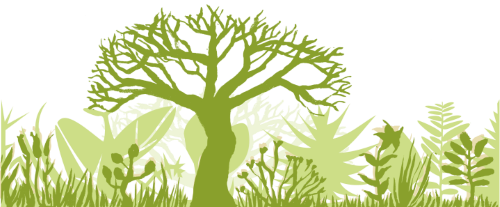 |
|
Restore Nature, Issue #17 October 14, 2024 |
HelloRESTORE NATURE NEWSLETTEROctober 2024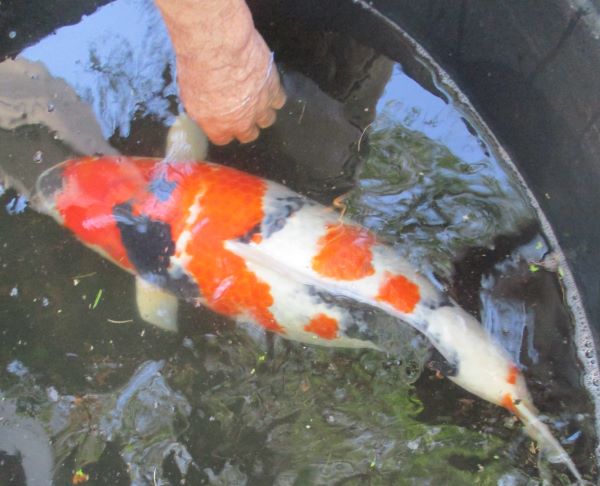
Hello biodiverse gardeners ! Today I tell a story of our backyard fish farm. This is a little aside from biodiversity into some of the work that needs doing in our garden, which is dominated by 3 Koi ponds and some tanks. That is my partner's thing, and follows different rules, for the sake of the health of his fish, while I do most of the gardening. You can see some albums about koi breeding and how we built the big pond by clicking the links below. koi-breeding-album.html pond-building-album-one.html You often hear that a hole dug in the ground and lined with plastic makes a good pond. After some years of having wet sand slides under the liner I built the first brick walls of the pond. Years later a friend Marc Niehaus gave his labour and intelligence to completing the job free of charge. With the help of this wonderful craftsman and his passion for fish we could build a pond of sufficient depth, which allows the fish to develop healthy cigar shaped bodies and not get pot bellied. That is until they are heavy with eggs as is the female fish above.
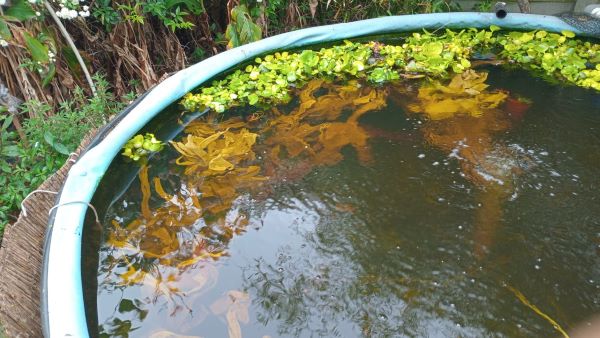 My partner interned at a Koi farm and was taught by a Japanese Koi breeder visiting the farm in South Africa. After a lot of labour and learning, my partner was paid for two years of work with his own selection of tategoi, or potentially great baby fish. Getting land to expand has been tricky but he's done really well for a backyard breeder, making a consistent income from breeding fish for the local market.
My partner interned at a Koi farm and was taught by a Japanese Koi breeder visiting the farm in South Africa. After a lot of labour and learning, my partner was paid for two years of work with his own selection of tategoi, or potentially great baby fish. Getting land to expand has been tricky but he's done really well for a backyard breeder, making a consistent income from breeding fish for the local market.
The time of year has come round where our fish are ready to breed. My partner inspects the equipment, gets the breeding tanks empty of small baby fish from last season, selects his parent fish and waits for the right weather patterns that trigger spawning. I get into doing some primoridial activities nearly as old as humankind itself and pertinent to fisher folk... mending nets ! I suppose I get to do this as I was a seamstress once, in our textile business days, with a real finger impaling industrial sewing machine too ! Many kinds of net are used, to cover ponds, to catch fish and carry fish, and above you can see the spawning nets hanging in the water the morning after. The sock net for moving fish was perished, and it took me a few hours to darn up all the rips and then back the net with some shade net for strength. The inside must remain soft and slippery though, in order not to scratch the fishes' skin as that can cause disease quickly. 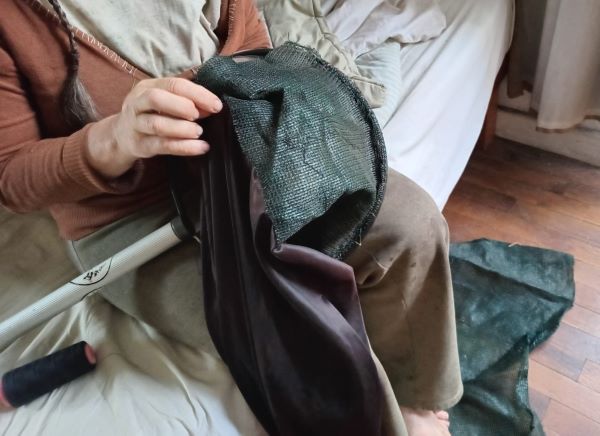 We filmed the moving of fish this year, working towards creating a tutorial on fish breeding. The females were moved first to the spawning pond. There they can get accustomed to the water and depth differences. They inspect the spawning nets hung in the pond, mouthing them and sucking them. This gets them in the mood. A few days later the males were added. At 2.30 in the morning Stephan went out with a flashlight and it had begun. At 7 am it was over and he removed all the adult fish from the spawning pond to their home pond. This has to be done or the adults will eat most of the spawn and eggs.
We filmed the moving of fish this year, working towards creating a tutorial on fish breeding. The females were moved first to the spawning pond. There they can get accustomed to the water and depth differences. They inspect the spawning nets hung in the pond, mouthing them and sucking them. This gets them in the mood. A few days later the males were added. At 2.30 in the morning Stephan went out with a flashlight and it had begun. At 7 am it was over and he removed all the adult fish from the spawning pond to their home pond. This has to be done or the adults will eat most of the spawn and eggs.
Below you can see the giants back in their castle. They are exhausted and the water is overloaded with protein for the time being, so they lurk in the murky depths on the bottom of the pond and are scarcely visible. After this comes an intense period of care. There are weeks of water management, disinfection, physical protection and frequent feeding that parallels the care of babies in other species. Here, though the parent fish would relish eating their own offspring, the inter-species relationship involves much nurturing. 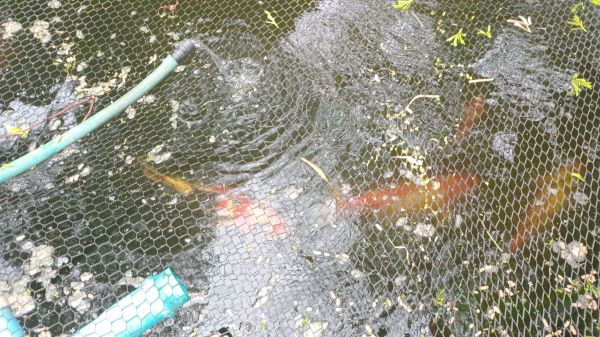
From this small business I receive the benefit of algae and fish water which are both very nutritious for plants. When available I mulch and irrigate with them. The filters provide a growing medium for monstrous water spinach and mint plants and ace cherry tomatoes which actually love growing in water. The vegetable plants provide the added benefit of removing nitrogen from the system. I also get obsessive pleasure out of designing pond systems for the fish. One day when there is money available I hope to build a swamp for receiving the dirty water from the bottom drain of that pond directly and lead the runoff to fertigate some areas of the garden underground. Such swamp systems are extremely productive for growing food. Another planned project is a much larger leak and flood proof system for my mother's garden in another part of town. If we were to breed edible fish we would need a lot more land to make it worthwhile, as the profits per fish would be smaller, and my partner would have to have some transitional training no doubt, or spend time learning how to deal with the new fish species, as they all have different requirements. However you can transfer much of our pond knowledge to raising fish like Telapia. The inputs to our system are high. Stephan puts in so much time, including the building of systems, those years of training, and we use fresh mains water many times a week, and electricity for driving the pumps constantly as Koi have high oxygen demands. Then there is the Koi feed. However, he gets a small income for his fish and much happiness. That is the main reason he has all my support. Happiness is in short supply in this world and a smile is worth plenty of blisters. Click the links below to see some more on our pond building process and some other pond styles and plants. pond-building-album-two.html pond-building-album-three.html garden-pond.html Topic suggestions welcomeYou may write to me anytime at the website greenidiom by filling out a comment. You can also use my webmail (website mail) address greenidi@greenidiom.com. Have you missed anything ?Please go to back issues right below if you want to catch up with what I've sent thus far as preamble for the course, as well as previous newsletters. |
| Back to Back Issues Page |